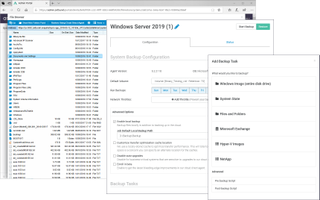IT Pro Verdict
Arcserve UDP Cloud Direct is undeniably easy to deploy but its limited restore features and indifferent documentation count against it. Get these sorted and Arcserve is ideal for SMBs looking to protect multiple systems and locations from one cloud portal.
Pros
- +
Super-simple deployment; Automatic database detection
Cons
- -
Item-level Exchange and local file restores not supported; Poor documentation; No hourly backups
Arcserve's UDP Cloud Direct is simple to deploy and easy to use - qualities that will immediately endear it to overworked IT departments. Two versions are available: we tested the Backup-as-a-Service (BaaS) edition, which promises pain-free cloud backup and recovery, but you can step up to the Disaster Recovery-as-a-Service (DRaaS) package, which adds in-the-cloud virtualised recovery of key systems.
Pricing for BaaS is based on your cloud storage requirements. The 1TB package costs 1,599 per year, or if you go for a 5TB subscription, you save over 300 per terabyte. DRaaS comes as a separate service, where you'll pay around 350 per year for a VM with one CPU and 4GB of RAM.
After signing up, you get access to a personalised web portal, from which you can download backup agents for Windows, Mac and Linux - although the latter two are file-only. It took mere seconds to install the agent on our Windows servers and enter our account details, after which each one popped up in the portal. The ease with which clients can be registered and managed makes Arcserve ideal for companies with multiple sites.
All of your clients can be viewed in the portal's Systems tab, and selecting one takes you to backup task creation. Oddly, you can schedule backups for selected days, but each task can only be run once a day at a specific time: if you want more frequent protection, you'll have to run extra jobs manually.
File and folder backup is supported on all platforms, and on Windows you can also secure entire systems as images. SQL Server and Exchange databases can be optionally backed up too, and you don't even have to specify the locations: the agent simply backs up all the databases it can find. You can even back up NetApp filers.

After installing the agent on our Hyper-V host, we were able to browse its VMs from the portal as well, and run agentless backups of selected ones. Installing the Cloud Direct virtual appliance on our VMware ESXi 6.7 lab host let us view its VMs from the portal, and choose which ones to protect with a single click.
Ongoing backup activity can also be monitored from the portal, and the agent has a System Tray popup that shows its progress. If bandwidth is an issue, bandwidth throttles can be applied in Kbits/sec to individual tasks.
Hybrid backups are simple to set up too because you can add a physical storage location to any task. This can be anything from a local disk or external USB drive to a NAS share or IP SAN; frustratingly, the sparse user manual doesn't detail how to configure this, but a little experimentation confirms that you can declare disk locations by entering their paths, while NAS shares can be accessed using UNC syntax.
When it's time to restore your data, you can just head to the web portal, choose a system, select the required recovery point and either restore it in its entirety back to the client or open the browser window and select individual files and folders to recover.
Unfortunately, Exchange item-level restores aren't supported: you can only select the entire database and recover it back to the host, whereas VMware VMs can be recovered as raw image files or directly to vCenter. It's not possible to restore files from local devices via the portal either, so if you want to quickly bring back a file from a NAS drive, you'll need to open up Explorer and copy it across by hand.
Those limitations take some of the shine off Arcserve UDP Cloud Direct, as do the lack of support for hourly backup jobs and poor documentation. If you can live with those specific issues, though, this is a great cloud backup solution that's ideal for SMEs looking to protect multiple systems and locations from one cloud portal.
Verdict
Arcserve UDP Cloud Direct is undeniably easy to deploy but its limited restore features and indifferent documentation count against it. Get these sorted and Arcserve is ideal for SMBs looking to protect multiple systems and locations from one cloud portal.
Dave is an IT consultant and freelance journalist specialising in hands-on reviews of computer networking products covering all market sectors from small businesses to enterprises. Founder of Binary Testing Ltd – the UK’s premier independent network testing laboratory - Dave has over 45 years of experience in the IT industry.
Dave has produced many thousands of in-depth business networking product reviews from his lab which have been reproduced globally. Writing for ITPro and its sister title, PC Pro, he covers all areas of business IT infrastructure, including servers, storage, network security, data protection, cloud, infrastructure and services.


